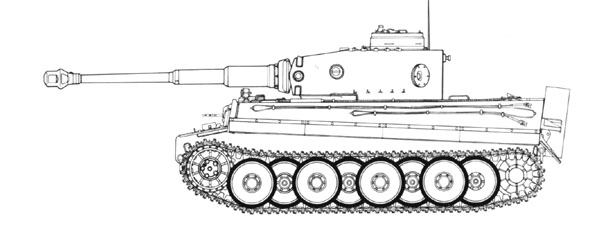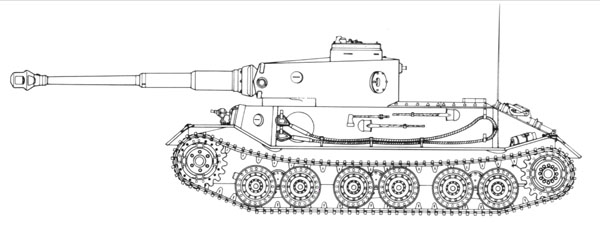 |
Henschel VK. 45.01(H) prototype |
One of the most difficult aspects about the Henschel VK. 45.01 prototype was that it had to be ready for Adolf Hitler's inspection on April 20th 1942. Because the order was emitted on 26 May 1941, the designers had less than a year for building and testing the vehicle: that was why so many parts were entirelly taken from previous projects such as suspensions and transmission/running gear from the the VK. 36.01 project (which had to use the 75mm tappered bore gun before it was discovered that no tungsten reserves were available for suppling enough rounds for them).
The engineering staff was under huge pressure and worked day and night to finish the tank by 17 April 1942, only forty minutes before it had to be loaded on the train for trasport to East Prussia, where the Fuhrerhauptquartier was. Because of the strict times, there was no chance to test the vehicle which was loaded on a trail and trasported to the rail station for its journey.
 |
Henschel VK. 45.01(H) prototype |
On April 19th 1942 both Porsche and Henschel VK. 45.01 prototypes were unloaded from the rail-wagons at 11 km from Rastenburg. After the crane left both on the ground, Porsche's tank sunk in the soft ground to the belly. Kurt Arnoldt, Henschel's chief engineer, offered Dr. Porsche to use the Henschel vehicle to tow the stuck Porsche's, an offer that Porsche brusquely refused. In reality no vehicle was truly ready to move, the Henschel tank having never moved with its own power.
The 11 km travel resembled an eternity to the competitors because none of the prototypes was able to drive for more than a few hundreds meters without breaking down: both tanks were overhauled several times along the route. At one point, Arnoldt had to drive pins into the troublesome final drive mechanism to keep the vehicle running.
Finally, the next day, 20th April, the prototypes were 'ready' for Hitler's inspection. There was notice that the Fuhred would have delayed its trip until 2 o'clock PM. Arnoldt immediately ordered the final drive of his creature to be torn down for repairs. Against all expectation the Fuhrer and his following entourage showed at 11 AM, causing, to say at least, big confusion in Henschel team which attempted to quickly re-assemble the final drive.
 |
Porsche VK. 45.01(H) prototype |
The trial consisted in an high speed travel of several hundreds meters to demonstrate their speed capability. The Porsche tank, presented as the Tiger, performed a succesfull run of 1,000 meters at 50 Kmh. Arnoldt drove his entry for 850 meters at 45 Kmh. On the return trip the engine was overheating in a way Henschel's chief engineer thought it might catch fire. He stopped at short distance from the reviewing group and managed to get away with it, hoping the engine to cool down before someone else had to drive it again.
In the meantime noises were rising among the reviewing people about the superior performance of Porsche design which led some of the tank industry to belittle the Henschel design. Arnoldt then approched Albert Speer and suggested a manouverabilty test: he knew that Porsche tank was very hard to steer and also that the regenerative steering final drive gearbox in his tank gave the best capability in any large tank in existence. The resulting tests were a success for Henschel and because of the other many lacks with Porsche's electric drive transmission and chassis, Henschel's prototype was chosen for series production. More, Porsche saw its 'Tiger' nickname to be officially assigned to the competitor vehicle!
Porsche tanks, which many hopes gave to its designer, got only a minor order for about a hundred tanks for employement in North Africa were their air-cooled diesel engines were believed to function efficiently: also this was disappointed and the order was rescinded in September 1942 after 90 chassis had been built. They finally become the notorious Ferdinand/ Elefants.
This page is online thanks to Geocities, the largest Web Community! Get your own free page at Geocities!!! |